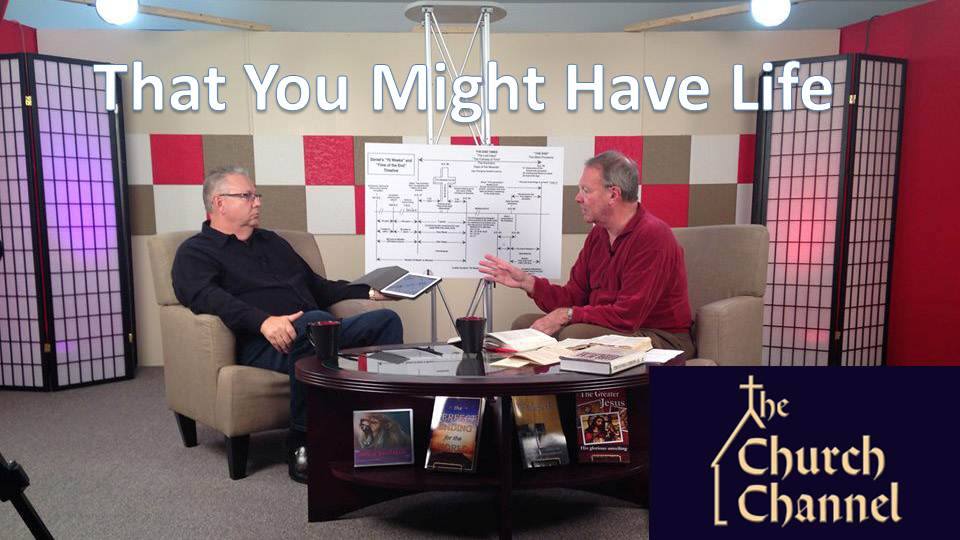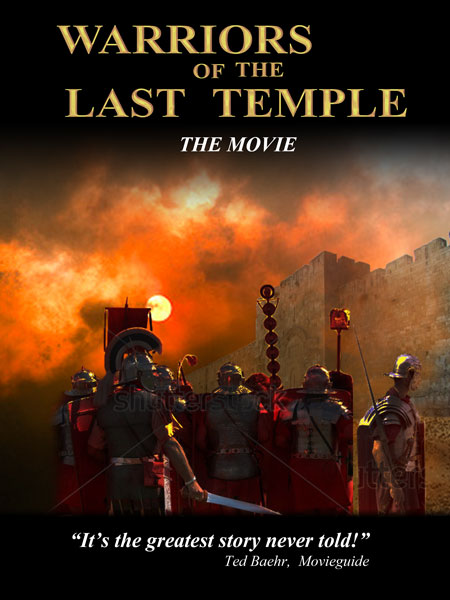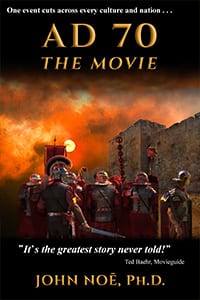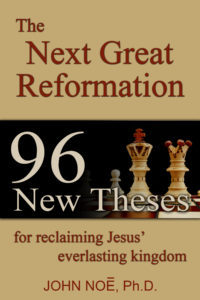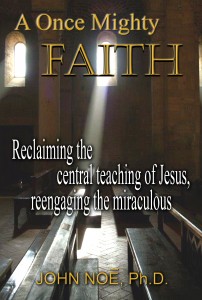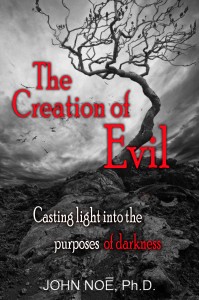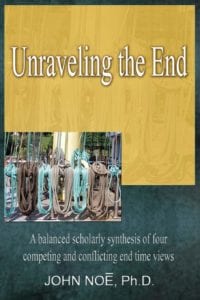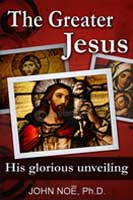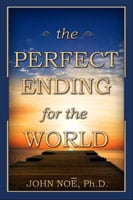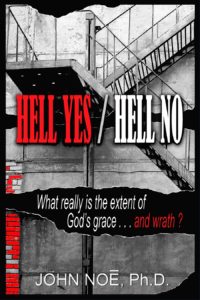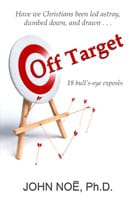ABOUT US
Welcome to the Prophecy Reformation Institute’s website. We trust you will find its contents not only stimulating and challenging but unique and rewarding. Be assured, we hold to a high view of Scripture but to a low view of what we Christians over the centuries have done to our faith and to the practice thereof.
Most of the contents herein are derived from the books, writings, and theological papers of Dr. John Noē. He is an ardent student of God’s Word and a passionate seeker of truth and understanding. He holds an earned Ph.D. in Theology, has been a member of the Evangelical Theological Society since 1994, and is the author of eighteen trade-published books.
As you proceed through this website, we encourage you to “test everything. Hold onto the good” (1 Thessalonians 5:21). If you agree, will you join us in helping to pioneer the next reformation of Christianity? If you disagree, please show us, in a civil manner and from the Scriptures, where we are in error. We have no desire to perpetrate error in any way. Thank you and enjoy!
PRI’s Purpose Statement:
The Prophecy Reformation Institute is a conservative, evangelical, and nonprofit organization dedicated to continuing the Reformation into the field of eschatology—end-time Bible prophecy—and reclaiming the central teaching of Jesus Christ, the kingdom of God.
Two Major Problems:
- “One of the most divisive elements in recent Christian history . . . Few doctrines unite and separate Christians as much as eschatology” – Christianity Today magazine, Feb. 6, 1987.
- The kingdom of God was the central teaching of our Lord Jesus Christ. Unfortunately today, it is no longer the central teaching of his Church.
Premise:
God is not the author of confusion (1 Cor. 14:33) in either of these above areas. We are. Therefore, it is not the character or the nature of God to have included in his Word any content that would create confusion, divisiveness, and ambivalence among Christians, and between Jews and Christians, concerning either end-time Bible prophecy or the everlasting, ever-increasing kingdom of God.
Furthermore, the trail of sensational prophecies and failed predictions of end-saying and kingdom-coming pundits has discredited the gospel and hamstrung the effectiveness of the Church and individual Christians long enough. Assuredly, we have misconstrued the facts of Scripture. And, indeed, we have. There is a serious need to reexamine what the Bible (properly translated) actually says.
Philosophy:
John Calvin, the 16th-century Reformer, said it well: “The church is reformed and always reforming.” We 21st-century moderns in the Church have not reached the point where reform is no longer needed. The embarrassing and perplexing fields of end-time Bible prophecy (or eschatology – the study of last things) and the kingdom of God (the central teaching of Jesus Christ), are two prime areas needing reform. And the time is now to bring accountability into these studies, honestly face the problems, and finally solve the issues which have been hanging around for centuries, majorly dividing us Christians, and greatly hamstringing our effectiveness in the world.
Our Mission Is Simple:
We are pioneering the next great reformation of the Christian faith.
Why Do We Need Another Reformation?
1). Much being preached and taught today in Christian circles is not found in and/or contradicts the Bible.
2). We are losing 6 to 7 out of every 10 of our youth from the faith by young adulthood.
3). We are losing the culture our forefathers in the faith came to America and founded.
4). The understanding of our faith has been watered down, dumbed down, and rendered much less effective than it should and could be.
5). The 16th-century Reformers said it well, “The church is reformed and always reforming.”
Goals
PRESENT the ultimate apologetic (defense) for the historical biblical faith—the literal, exact, chronological, and sequential fulfillment of Daniel’s two time prophecies in complete harmony with the plain, face-value meaning of all New Testament time and imminency statements. No gaps, no delays, no artificial or imposed exegetical gimmicks (see Dan. 9:24-27; 12:4, 7, 11-12).
The historically defensible interpretation has greatest authority. That is, interpreters can have maximum confidence in their understanding of a text when they base that understanding on historically defensible arguments. 1
RECONCILE the Church’s categorization system of confusing and conflicting end-time views/positions by a solution of synthesis—keeping the strengths of the four major views and dumping their weaknesses [preterist, idealist/amillennial, postmillennial, and premillennial] (2 Cor. 5:18-19; 1 Thess. 5:13; 1 Pet. 3:11).
STRENGTHEN the case for biblical inerrancy by removing the discrediting dilemma of “non-occurrence” – i.e., Jesus’ supposed failure to come in age-ending judgment and finish the work He started (John 9:4; 17:4).
FACILITATE the ongoing expansion of God’s eternal, complete, unending, and ever-increasing kingdom and its present-day realization of all blessings that were promised and delivered (Matt. 6:33; Jude 3).
ENCOURAGE a positive, kingdom-oriented worldview of the future and the Church’s and every Christian’s dynamic role in the world God so loves and created (John 3:16-17).
PROMOTE the beauty and perfection of a “once-for-all delivered” faith (Jude 3) – not one with more yet-to-be delivered, but one with great unrealized potential.
IGNITE the next great Reformation with the cry of “once for all delivered” – a corollary to the Protestant Reformation’s cry of “the just shall live by faith” (Rom. 1:17; Hab. 2:4).
1 Klein, Blomberg, and Hubbard, Jr., Introduction to Biblical Interpretation, 149. Bold emphasis mine.
Distinctive Bio & Voice
Dr. John Noē (pronounced “No-ee”) is a conservative evangelical scholar and theologian who holds an earned Ph.D. in Theology. He is president of the Prophecy Reformation Institute and a 26-year member of the Evangelical Theological Society, where he has presented seventeen theological papers and been published in its prestigious academic journal, The Journal of the Evangelical Theological Society.
Dr. Noē is also a motivator, peak performer, world mountain climber, and an inspiration. He has written two, best-selling, personal-development, and motivational books. They are: Peak Performance Principles for High Achievers (Frederick Fell ’84, revised ed. ‘06/Berkley ‘86) and People Power (Thomas Nelson ‘86/Berkley ‘88).
During the 80s and 90s, Peak Performance Principles was featured in Amway’s “Top Ten Recommended Books.” Additionally, the Amway Corporation purchased 25,000 copies to give to their employees and marketing associates.
Since then, Dr. Noē has authored and published fifteen theological books—a treasure-trove of biblical knowledge and insights. Like his first two books, these books are written a popular fashion. Nonetheless, this prolific author believes that his most successful book has yet to be published.
Noē is also the founder, past president, and chairman-of-the-board emeritus of a successful management training, consulting, and service corporation that served many Fortune 500 clients in the Midwest and on the East Coast. Clients included: General Electric Aircraft Engine plants, Ford Motor Company plants, Caterpillar Tractor plants, and major steel mill facilities. He has climbed around the world, including the Matterhorn, Mount Kilimanjaro, Mount Kenya, Mount Rainier, and the Grand Teton. He’s also driven racecars, carved out a niche in the world, and wrote the books on peak performance and people power.
TV, Radio, and Media: Since 1985, John Noē has been interviewed on hundreds of national and local TV and radio programs across the United States. These include Larry King Live, twice on CNN Newsnight, four times on CBN’s The 700 Club, and nine times as featured guest on TBN’s “The Church Channel” on Dr. Lynn Hiles’ program That You Might Have Life.
He has also been featured in articles in the Los Angeles Times Syndicate, The Washington Post, The Indianapolis Star, and Fulfillment Magazine, to name a few.
Hence, Dr. Noē is a media-savvy and passionate communicator who is available and eager to discuss, debate, and promote his various books and other writings.
Currently, he serves as president of the Prophecy Reformation Institute, an educational, teaching, and training ministry. He is also co-host of the weekly YouTube series “Greater Than We Believe,” along with his co-host, Stephen King (not the horror writer).
He is co-admin with Bill Evans, the Truckdriver Theologian, of the Facebook group also called “Greater Than We Believe.”
John and his wife Cindy live in Indianapolis. They have two grown children and 16 grandchildren.
Dr. Noē’s growing and distinctive voice has been endorsed by such notables as:
- 1984 – OG MANDINO, author of the bestselling motivational book The Greatest Salesman in the World (his books have sold over 50 million copies and have been translated into over twenty-five different languages) ironically penned on front-cover of Noē’s first book, Peak Performance Principles for High Achievers – “After reading this marvelous book I realize how little I have accomplished . . . compared to what I could have done. But, it’s not too late!”
- 1988-- ZIG ZIGLAR – Internationally known motivational speaker and author of numerous books including See You At The Top on the front-cover endorsement for Noē’s People Power book – “Loaded with insights, guidelines, wisdom, common sense and How To’s that will help you move faster toward real success!”
- 1994 – ROBERT H. SCHULLER, former Senior Pastor, The Crystal Cathedral, and author endorses Noē’s book The Apocalypse Conspiracy – “It surely is a message that is desperately needed . . . . It is high time that this position be articulated and presented in writing the way you are doing.”
- 1999 – JAMES EARL MASSEY, Former Sr. Editor, Christianity Today, Dean Emeritus, School of Theology, Anderson University & Distinguished Professor-at-Large states on the back-cover of Noē’s book Beyond the End Times – “Noē’s book just could be the spark that ignites the next reformation of Christianity.”
- 1999 – MARK GALLI, Book Review Editor for Christianity Today magazine featured Noē’s book, Beyond the End Times in a review article and termed it – “exegetically interesting reading.”
- 1999 – WALTER C. HIBBERT, Former Chairman, Great Christian Books about this same book attests – “Your treatment of the ‘end of the world’ is the best treatment of this idea . . . . Your book could really open the eyes of a lot of people.”
- 2002-2010 – MOVIEGUIDE’S TED BAEHR, Chairman of the Christian Film and Television Commission, an American media critic, and Publisher and Editor-in-Chief of Movieguide magazine, website, and biweekly journal in the LA. After meeting Dr. Noē at a theological conference and reading his books, Baehr approached Noē about teaming up to write a big-screen, Hollywood movie centered around the timeframe of Noē’s Ph.D. dissertation and books, because . . . “We need your POV.”
Dr. Baehr characterizes the resultant, high-concept, action-adventure, historical, political, but post-biblical epic and screenplay, thusly:
- 2004-2006 – EVANGELICAL THEOLOGICAL SOCIETY’S ANNUAL MEETING & JOURNAL, after Noē spoke during a special afternoon Group Study Session at ETS’s Annual Meeting in 2004 and on the topic of eschatological reform, Responder Grant R. Osborne, Professor of New Testament at Trinity Evangelical Divinity School and author of the book, Revelation (2002), part of Baker Books’ Exegetical Commentary on the New Testament series, recommends that Noē write up his comments and submit them in the form of an article for publication to the editor of the prestigious Journal of the Evangelical Theological Society (JETS) along with his recommendation for publication. That article was published in JETS, Vol. 49, No. 4, (Dec. 2006) and titled: “An Exegetical Basis for a Preterist-Idealist Understanding of the Book of Revelation.”
- 2010-to date – EAST2WEST PRESS – Dr.Noē formed a publishing company and writes and publishes a growing treasure-trove of next-great-reformation, theology books.
- 2020 – Noē believes his greatest books are yet to be published.

P.I.P.S. Summary
Preterist, Idealist, Postmil Synthesis
John Noē’s Eschatological Solution for Unifying the Divisiveness of Four Modern-day End-time Views
Preterist = Past in fulfillment
Everything Jesus said would happen regarding the end times happened exactly as and when He said it would and exactly as and when every New Testament writer expected it to happen as they were guided into all truth by the Holy Spirit (John 16:13).
-
- No time gaps, no exegetical gymnastics, and no delays.
- Sadly, the Church later invented “delay theory” in direct contradiction of Scripture (see Hab. 2:3; Ezek. 12:21-23; Heb. 10:37) – and “Surely the Sovereign Lord does nothing without revealing his plan to his servants the prophets” (Amos 3:7). No delay was ever revealed.
- In other words, their 1st-century and inspired expectations and time statements were the correct ones, not our 19-centuries-and-delayed expectations and any-day-now statements.
- Key consideration: If their Holy-spirit-led expectations proved false by nineteen centuries and counting—as many contend—how can we expect them to have conveyed other aspects of our faith along to us accurately—such as the requirements for salvation? Perhaps, they got that wrong, too?
- Hence, the end that came right on time was covenantal not cosmic even though cosmic/apocalyptic language was used to describe it. This is in keeping with this type of language’s long-established and many uses with God’s judgments of peoples and nations throughout the Old Testament.
- Furthermore, the Gloria Patri, the famous doxology and confessional of the historic Church, has it right in its confirmation of this biblical truth and understanding:
Glory be to the Father, and to the Son, and to the Holy Ghost,
As it was in the beginning, is now and ever shall be.
World without end, Amen.
- The historical documentation of this fulfillment is scripturally sound, well-developed, and totally applicable as Klein, Blomberg, & Hubbard appropriately counsel . . .
The historically defensible interpretation has greatest authority. That is, interpreters can have maximum confidence in their understanding of a text when they base that understanding on historically defensible arguments.1
1 William W. Klein, Craig L. Blomberg, Robert L. Hubbard, Jr., Introduction to Biblical Interpretation, (Dallas, TX, Word Publishing, 1993), 149.
Idealist = Fully ongoing in relevance and reality, here, now. and onward
Arguably, the Book of Revelation is a fourth version of Jesus’ Olivet Discourse (Matt. 24 & 25; Mark 13; Luke 21). It covers the same time frame and age-ending events re: the destruction of Jerusalem and its Old Covenant, animal-sacrifice, Temple system circa A.D. 66-73.
- A strong case can and has been made that the Book of Revelation was written prior to those age-ending events.
- The entirety of Revelation’s prophecy is bookended by time statements in its Chapters 1 and 22 for things that were short to take place. Again, all this occurrence has been historically documented.
- But Revelation’s prophecy also provides the exegetical basis for extrapolating the entirety of its prophecy beyond its original audience (seven churches in Asia Minor), fulfillment time frame, and historical reality.
- In Revelation 10:9-11, John is told by an angel to take the little scroll from which the majority of the prophecy is unfurled (see Rev. 5 & 6:1), to eat it, and it would turn both sour and sweet in his mouth because of its judgments and blessings. This is a grotesque sign and a symbol contained in a book filled with signs and symbols. But it points to real literal realities.
- Lastly, the angel explains to John and us today that “You must prophesy again about many people, nations, languages, and kings” (Rev. 10:11). This is an entirely different audience than to whom the Book of Revelation was written in the first place (see Rev. 1:4, 11, 20 also chapters 2 & 3).
- In this manner, Revelation’s entire prophecy is extrapolated beyond its historical, eschatological fulfillment into an idealist ongoing relevance of timelessness and universality in an apocalyptically revealed manner.
- Based upon this scriptural grounding, we have the exegesis basis for the continuing manifestations of God’s glory and Christ’s active presence, personal involvement with his creation, and many different countless coming (some you do not want to have happen to you) following the end of the age circa A.D. 66-73.
Postmil = Kingdom-driven optimism
The major strength of the postmillennial view throughout Church history has been and still is its optimistic view of the everlasting and ever-increasing kingdom of God that Jesus came to earth to bring into human history, along with his injunctions for every Christian to be involved with expanding this kingdom’s message, works, greater works, and realizations in lives and throughout societies.
- That eschatological and final form of God’s kingdom arrived fully established 19-some centuries ago in the form of a fetus.
- And from that time on has continued to grow and expand, unendingly.
- To that kingdom’s increase there shall be no end (see Isa. 9:6-7; Luke 1:33)
Thus, according to Noē:
The kingdom of God is the most important and all-encompassing concept of Scripture. So much is contained within it! The kingdom was also the reason Jesus was killed. Today, sad to say, the kingdom is one of the most misunderstood, misconstrued, marginalized, confused, abstracted, abused, contested, and ignored realities of Christianity. And we are reaping mighty consequences.
Today most churches rarely mention the kingdom, let alone preach, teach, obey, and practice its established reality and intrinsic elements. For centuries, even theologians have been divided over its time of arrival and nature. All this confusion and confounding differences have led to a number of conflicting beliefs, behaviors, and avoidance practices that have no foundation in the Bible. And yet, they have long held sway over countless Christians.
The fact now is, the concept of the kingdom of God—the central teaching of Jesus Christ—has become corrupted and doctrinally written out of the faith by the traditions of men. Consequently, our “once mighty faith” termed Christianity is now characterized as having been “tamed.” Ironically, this taming was not the result of outside opposing forces. Rather, it’s the product of sabotage, neglect, and ignorance from within. Again, we inhabitants of planet Earth are paying a huge and dreadful price for this deficiency.2
2 John Noe, A Once Mighty Faith (Indianapolis, IN.: East2West Press, 2016, 1.
Synthesis
Throughout the last hundred years calls for a synthesis have resonated from many Christian theologians bemoaning the fact that never before in Church history has there been a synthesis solution proposed for the biblical field of end-time views. Rather, it has been termed:
"One of the most divisive elements in recent Christian history. . .
Few doctrines unite and separate Christians as much as eschatology.” 3
But now a credible, comprehensive, and scripturally sound solution of synthesis has been developed and is being offered for resolving this divisive element and unifying the Church’s dilemma of confusing and conflicting end-time views.
This synthesis is systematically presented in
-
- John Noē’s trade-published book: Unraveling the End: A balanced scholarly synthesis of four competing and conflicting end-time views. See BOOKS.
- Also, in a 12-page paper titled: “Unraveling the End ETS Theological Paper” under ARTICLES.
3 Kenneth S. Kantzer, ed., “Our Future Hope: Eschatology and Its Role in the Church,” Christianity Today, 6 February 1987, 1-14 (I).
P.I.P.S – The Backstory
– Preterist, Idealist, Postmil Synthesis –
A Unifying Solution to a Divisive Stalemate
Time and again, for nineteen centuries and counting, the inspiration, authority, and reliability of Holy Scripture has been brought into question and the Church made to look like a joke in the eyes of the world as predictions of Christ’s so-called Second Coming and Return and other related end-time events have supposedly come and gone without fulfillment. Adding to this humiliation is the reality that the biblical field of study known as eschatology (end-time views) is termed:
"One of the most divisive elements in recent Christian history. . .
Few doctrines unite and separate Christians as much as eschatology.” 1
The P.I.P.S Premise and Nature of the Beast (System)
- A fair-minded review and objective analysis reveals that no single view or interpretative position has all the right answers. Each contains blind spots and presuppositional biases that force its proponents into subscribing to erroneous concepts and flawed interpretative methodologies.
- Furthermore, no particular view has maintained its dominance throughout Church history.
- Consequently, the hotly debated, highly contested arena of eschatology has been likened to a “war zone” comprised of four “armed camps.” Others have characterized eschatological discourse as a mine field—one false step and you get blown away by your opposition. Indeed, its issues are deeply embedded and traditions fiercely defended by proponents willing to fight to the “death” for their particular view. The bottom line is eschatology threatens the focus and effectiveness of the Church.
- What is needed is a totally different approach to understanding this broad and critically important arena of divine revelation—i.e., God’s establishment, sustaining, and ever-increasing plan of redemptive for his people and world?
- Never, however, has a credible, comprehensive, and scripturally sound solution been offered for resolving this divisive element, unifying the Church’s dilemma of confusing and conflicting end-time views, and healing the open wounds.
1 Kenneth S. Kantzer, ed., “Our Future Hope: Eschatology and Its Role in the Church,” Christianity Today, 6 February 1987, 1-14 (I).
The P.I.P.S Backstory
P.I.P.S. – Preterist-Idealist-Postmillennial Synthesis, many years in the making, represents that unique solution. John Noē credits the Lord for his inspiration in the early 90’s. But because of the scope, nature, and potential of the concept, Noē, already an author six trade-published books—two bestsellers, instinctively knew that simply writing another book was not enough. This project demanded testing and review at the highest levels of scholarship before it would be ready for general consumption. For this author that meant taking this solution of synthesis to the Ph.D. dissertation level.
Hence, Noē’s first hurdle was to convince his doctoral committee—three dispensational premillennial professors—that his proposed synthesis-solution was a viable Ph.D. dissertation topic. That meant proving to them that this approach had never been done before in Church history and would meet the high-bar of the doctoral-dissertation standard of being “a contribution to knowledge.” In other words, it could not merely be a report or a survey as is acceptable for a master’s level thesis. The burden of providing that proof rested solely on Noē.
Noē provided this proof via an extensive literature review documenting that no comprehensive synthesizing work of this type or magnitude had ever been conducted. Then, after much wrangling, his committee approved his proposal but doubted that he could pull it off into a full-blown, approvable, and defended dissertation. Two years, three revisions, and 600 pages later Noē successfully completed and orally defended his Ph.D. doctoral dissertation presenting the P.I.P.S concept and its solution of synthesis.
Documented Calls for a Solution
Noē’s desire for this solution of synthesis was for it to be a therapeutic and healing approach, capable of fostering and advancing discussions, resolving differences, and eventually ending the Church’s divisive end-time dilemma. During this process he cited numerous scholars admitting that the Church lacks a unified voice and is trumpeting an “uncertain sound” (see 1 Cor. 14:8) in the area of eschatology. Many were calling for a solution, and some a solution of synthesis.
For Noē, no one better epitomized our current eschatological dilemma and his hope and heart for this synthesis approach than Frances A. Schaeffer in his 1984 book, The Great Evangelical Disaster with this profound insight:
The history of theology is all too often a long exhibition of a desire to win. But we should understand that what we are working for in the midst of our difference is a solution—a solution that will give God the glory, that will be true to the Bible, but will exhibit the love of God simultaneously with his holiness.2
Noē uncovered more credible documentation that no comprehensive works of synthesis was known to exist.
In 1937, Louis Berkhof in his book, The History of Christian Doctrines, viewed “the doctrine of the last things . . . [as] one of the least developed doctrines.” He further believed that “it may be . . . we have now reached that point in the history of dogma in which the doctrine of the last things will receive greater attention and be brought to further development.3 Berkhof also concluded that “eschatology is even now the least developed of all the loci of dogmatics.”4
In 1973, in the preface of J. Barton Payne’s Encyclopedia of Biblical Prophecy, Payne quotes Dwight Pentecost in noting that “there has been little attempt to synthesize the whole field of prophecy . . . and there is a great need for a synthetic study and presentation of Biblical prophecy.”5
In 1998, Millard Erickson in his book, A Basic Guide to Eschatology, still identified eschatology as “the one remaining undeveloped topic of theology.”6 Erickson also referred to J. Barton Payne’s previous attempt “to synthesize the major strengths of the three methods of prophetic interpretation: historical, futurist, and preterist.”7 Payne’s treatment, nevertheless, was cursory and shallow. Even Payne himself admitted:
. . . any of the three methods if used rigorously . . . is productive of confusion. Actually, there are not a few alleged antecedents to Christ’s return that may better be understood as having attained their fulfillment in the ancient past and hence as of no continuing prophetic significance whatsoever. Space forbids an exhaustive treatment of Biblical prophecy in reference to these three methods of approach.8
Unfortunately, Payne’s book did not accomplish much of a synthesis. Hence eschatology remains “an object of criticism.”9 But in Noē’s proposed dissertation, and in his subsequent book, Unraveling the End, “space” would not “forbid” doing what Payne proclaimed but fell far short of accomplishing.
Also conspicuous, Noē discovered that no creedal council during the early centuries of Christianity ever debated or discussed eschatology. Even the 16th-century Reformers spent little time with it and paid it scant attention.
Nowadays, growing numbers of theologians are feeling that the embarrassing and perplexing arena of end-time biblical prophecy, or eschatology, is the next major area of Christianity ripe for reform.
The renowned theologian George Eldon Ladd maintained: “the easiest approach . . . is to follow one’s own particular tradition as the true view and ignore all others, but intelligent interpreters must familiarize themselves with the various methods of interpretation that they may criticize their own views.”10
John Warwick Montgomery further and wisely advised that “the search for truth can never be limited to the categories of a single modern school of thought.”11
Even the chairperson of Noē dissertation committee, David L. Turner, a progressive dispensationalist, in a 1989 article in the Grace Theological Journal titled, “The Structure and Sequence of Matthew 24:1-41,” advocated that “some combination of the two (preterist-futurist views)” offers “the most promising solution to the exegetical difficulties of this passage.”12
In a 1999 Christianity Today magazine article titled, “Is Revelation Prophecy or History?”, David S. Dockery, President of Union University in Jackson, TN, recommended that the Book of Revelation be approached on a synthesis basis. Here’s how he put it:
Both the futurist and preterist views have their strengths and weaknesses. Instead of choosing only one or the other, a ‘both/and’ approach that applies the strengths of each is a better option. . . . Combining the preterist and futurist views allows us to understand both that the message of Revelation spoke directly to John’s own age and that it represents the consummation of redemptive history. . . . The preterist position by itself fails to understand that Revelation confronts the modern reader with promises, challenges, and choices that are similar, if not identical to those faced by the book’s original readers. The futurist position by itself is prone to see Revelation as a crystal ball with a literal timetable of events that will happen in the future.13
Lastly, Stanley J. Grenz, in another Christianity Today article certainly grasped the validity of a synthesis concept. Although he did not mention the preterist view, he did discern that “we would be mistaken if we merely weighed the evidence, chose one, and ignored the other two. The Spirit has something important to tell us in each of the three traditional views of the millennium.”14
While Noē has basic agreements and disagreements with each of the above synthesis suggestions, they are, indeed, steps in the right direction. For that he applauds them. But all are too limited in scope and fell far short of a full synthesis.
2 Frances A. Schaeffer, The Great Evangelical Disaster (Wheaton, IL.: Crossway Books, 1984), 176-177.
3 Louis Berkhof, The History of Christian Doctrines (Grand Rapids, MI.: Eerdmans, c1937, 1959), 267.
4 Louis Berkhof, Systematic Theology (Grand Rapids, MI.: Eerdmans, 1939), 664.
5 J. Barton Payne, Encyclopedia of Biblical Prophecy (Grand Rapids, MI.: Baker Books, 1973), vi. From J. Dwight Pentecost, Things to Come (Findlay, OH.: Dunham Pub. Co. , 1958), viii.
6 Millard Erickson, A Basic Guide to Eschatology (Grand Rapids, MI.: Baker Books, 1977, 1998), 11.
7 Ibid., 179.
8 J. Barton Payne, The Imminent Appearing of Christ (Grand Rapids, MI.: Eerdmans, 1962), 106.
9 Geerhardus Vos, Biblical Theology: Old and New Testaments (Carlisle, PA.: The Banner of Truth, 1948, 1975), 287.
10 George Eldon Ladd, A Theology of the New Testament (Grand Rapids, MI.: Eerdmans, 1974), 670.
11 John Warwick Montgomery, The Suicide of Christian Theology (Newburgh, IN.: Trinity Press, 1970), 177.
12 David L. Turner, “The Structure and Sequence of Matthew 24:1-41: Interaction with Evangelical Treatments,” Grace Theological Journal 10.1 (1989): 3, 26.
13 David S. Dockery, “Is Revelation Prophecy or History?” Christianity Today, 25 October 1999, 86.
14 Stanley J. Grenz, “The 1,000-year Question: Timeless truths behind the debates over Christ’s return,” Christianity Today, 8 March 1993, 35.
Noē’s Dissertation Premise – Simple, Straightforward, and Fourfold (excerpted)
- God is not the author of our confusion in eschatology (1 Cor. 14:33, KJV)—we are. I assumed that it was not and is not God’s character or nature to have included in his Word any content that would create the amount of confusion, conflict, divisiveness, and/or ambivalence we see among Christians in this arena of eschatology. Personal interpretations have “muddied the waters” for everyone. I further assumed that we are the ones who have misconstrued the whole thing, and that this impasse could be resolved—scripturally.
- Each of the four major views focuses on the Second Coming/Return of Christ as the central, pivotal and controlling end-time event. So get this one right and the other events will fall readily into place. The four views in order of their prominence today are: dispensational premillennialism, amillennialism, postmillennialism, and preterism.15
- Each view has principal strengths and weaknesses that can be identified through a scripturally disciplined approach grounded upon what the text actually says and does not say—properly translated. Eschatology is an area filled with problems caused by both additions and subtractions to the text. These are necessitated by the traditions of men and will not stand up to an honest and objective test of Scripture. Yet more often than not, we are unaware of the weaknesses inherent in our own view, until someone points them out to us. They are blind spots. And unlearning is the hardest form of learning. I also knew I’d have to be both objective and gracious in exposing these weaknesses for each view.
- The solution would be a solution of synthesis—discarding the weaknesses, keeping the strengths, and synthesizing the strengths into one meaningful, coherent, and cogent view that is more Christ-honoring, Scripture-authenticating, and faith-validating than any one view in and of itself. Since each view has grasped a portion of the biblical truth regarding the end times, I proposed a synthesis treatment that would meet all hermeneutical and exegetical demands, and not contradict itself. This was significant because no one had ever done this before to the degree and scope I was proposing and none of the four views themselves meet this criterion.
15They are not Preterism, Historicism, Futurism, and Idealism, as some suggest.
Further Major Testings
In 2006 – a peer-review article written by Noē is recommended for and published in the Journal of the Evangelical Theological Society (Vol. 49, No. 4, Dec. 2006) and titled, “An Exegetical Basis for a Preterist-Idealist Understanding of the Book of Revelation.” (See ARTICLES and “Preterist Idealist Academic Journal Article.”
In 2009 – Noē is invited to conduct a 13-week seminar series titled “Unraveling the End: A Biblical Synthesis of Competing Views” at the headquarter church of the Church of God, Anderson, Indiana. (See PODCASTS and “Unraveling the End Audio.”
In 2014 – Noē presents a theological paper presented at the 59th Annual Midwest Regional Evangeli cal Theological Society Meeting and titled: “Unraveling the End: A Biblical Synthesis of Four Competing and Conflicting End-time Views.” (See ARTICLES and “Unraveling the End ETS Theological Paper.”
In 2014 – Noē publishes the book, Unraveling the End: A balanced scholarly synthesis of four competing and conflicting end-time views – available on Amazon.com. (See BOOKS for a synopsis).
Additional Observations & Applications
The solution of synthesis Dr. Noē has presented, defended, and tested was and is not his invention or creation. For it was clearly embedded in God’s Word all along. It simply awaited a willing vessel to come along, discover, and present it.
Most certainly, his proposed synthesis solution for unifying of this confusing, conflicting, and divisive field of knowledge has far-reaching implications, consequences, and ramifications. As Dr. James Earl Massey, Former Sr. Editor, Christianity Today, Dean Emeritus, School of Theology, Anderson University & Distinguished Professor-at-Large noted on the back cover of one of Noe’s books, The Perfect Ending for the World:
“Noē’s book just could be the spark that ignites the next reformation of Christianity.”
But indeed, only God can bring about this synthesis and unity of doctrine. If He so desires, Noē believes this cathartic solution would produce a reformation greater and more far-reaching than the Protestant Reformation spawned by Martin Luther and others in the 16th century.
Noē’s hope is this synthesis will also be your opportunity to re-explore and unlearn many traditional interpretative practices and conclusions that will simply not stand up to an honest and sincere test of Scripture (1 Thess. 5:21; Acts 17:11).
Below is a list of further major insights into our “once for all delivered” faith (Jude 3) and its ongoing relevance that are to be gleaned from this synthesis-solution approach:
- Scripturally unsupported paradigms drive all of four of the major eschatological views. These paradigms are based on what is termed “the five chief moments.” They are:
1) Second Coming/Return of Christ,
2) Last/Final Judgment,
3) End of the World/End of Time,
4) Return of the Kingdom to Israel.
5) The Eternal State
These non-unscriptural expressions and false notions must be cleared off the table of discussion and debate before a synthesis of strengths and a discarding of weaknesses can be effectively pursued and achieved.
- This synthesis asserts that all end-time prophecy was fulfilled exactly as and when Jesus said and exactly as and when every New Testament writer expected as they were guided into all truth by the Holy Spirit in circa A.D. 70. Thus, this is preterist.
- Furthermore, all fulfilled prophecies, acts, commands, and teachings of Christ are ongoing in relevance, timelessness, and universality in an apocalyptically revealed manner. See Rev. 10:9-11 for the exegetical basis. The passage addresses an entirely new and different audience than to whom the Book of Revelation was written in the first place (Rev. 1:4, 11, 20). Thus, this is idealist.
- Likewise, this synthesis recognizes Christ’s unending and ever-increasing kingdom as the ascended, exalted, glorified Jesus continues being active and involved with his creation on earth and in heaven. Thus, this is postmil.
- Note* For a comprehensive treatment of P.I.P.S. and the listings of the strengths and weaknesses of each of the four views, see: Dr. John Noē’s book Unraveling the End: A balanced scholarly synthesis of four competing and conflicting end-time views – – available on Amazon.com. (See BOOKS for a synopsis).
Testimony of Bill Evans, The Truckdriver Theologian, and Co-Admin with Dr. Noē on the ‘Greater Than We Believe’ Facebook Group [click here to view the group].
→ Also see the ‘Greater Than We Believe’ YouTube video series [click here to view the playlist]
7/16/20 Bill Evans: "The discussion of John Noē’s 30 years of study and writing is the purpose this FB group was created. That’s why I’m sharing his GTWB video series, his book titles and his website with so many of my friends. To be clear, it’s not about esoteric or irrelevant theoretical concepts. It’s about understanding the fullness of what we have in Christ, accurately handling His word, and for us to be sharpened & energized in our focus to live lives worthy of the Lord, and call people into fellowship with God for service in His kingdom now, AND on into ETERNITY."
7/19/20 – Bill Evans: "I’ve seen demonstrated in John Noē a spirit of humility and a reliance on Scripture. What’s more, he constantly cites numerous sources from across the spectrum of Christendom, from early Church Fathers to NT Wright, to Rushdoony, Gentry, Chilton and DeMar.
"Brothers, no one is denying any of the three doctrinal pillars central to our common faith (Trinity, Solas, and biblical authority) We are proposing a rather straightforward but previously overlooked synthesis of the best of the four major and current end-time views and biblical scholarship, as well as in a spirit of cooperation and optimism and kingdom advancement. This synthesis doesn’t propose to rob the saints of some cherished eschatological heritage, but to enhance it.
"Churchman and scholars have agreed that such a synthesis is needed, but has not been attempted. John Noē spent 30 years of his life doing just that. This is not a mere esoteric or theoretical pursuit. No less than RC Sproul noted that 70% of the New Testament has eschatological implications. While the Church is presently finding itself awash in challenges, deemed increasingly irrelevant and powerless, Dr. Noē has not been content to sit and curse the darkness. Rather, he has struck a match and lit a candle. His main obstacle has not been superior biblical exegesis or a wicked spirit, but tribalist circling the wagons, traditions of men, and paradigms which compromise and marginalize Sola Scriptura, all amidst baseless charges of heresy.
"If you do not have the interest or the time to familiarize yourself with what is actually being proposed herein, please don’t wax prophetic against him or myself until or unless you do. Hurling anathemas is a reaction, not a refutation.
"Grace and peace to you from God the Father and our Lord Jesus Christ. May the joy of the Holy Spirit be your strength."

